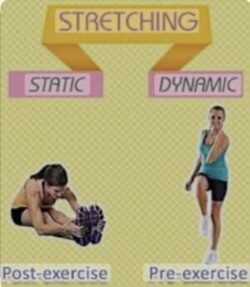Warming up and cooling down are the cornerstone of any workout routine. This makes it even more surprising that it is one of the most common things that people skip in their routines.
Physical activity can be very demanding on our bodies, as it puts our joints and muscles under a lot of stress, making it essential to warm-up our muscles before a workout and cool down after it.
In this article I am going to give you my top 10 dynamic warm-up stretches to get the blood flowing to you muscles before a workout, as well as my top 10 static stretches to cool down and relax your muscles after a workout.
But, before we cover the best warm up and cool down stretches. We are going to discuss the importance of warming up and cooling down when performing any physical activity to prevent injuries and speed up muscle recovery.
Importance of Warming Up
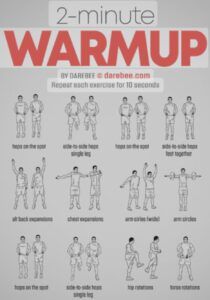
Warming up is essential before any physical activity for many reasons. Here are some of the reasons why it is so important:
- 1. Increases blood flow to muscles, delivering oxygen and nutrients, which prepares them for exercise.
- Raises body temperature, making muscles more flexible and less prone to injury.
- Activates the nervous system, improving coordination and reaction time.
- Mentally prepares you for the upcoming workout, enhancing focus and concentration.
- Reduces the risk of muscle strains, sprains, and other injuries.
Overall, warming up primes your body and mind for optimal performance and helps you get the most out of your workout while minimizing the risk of injury.
Importance of Cooling Down
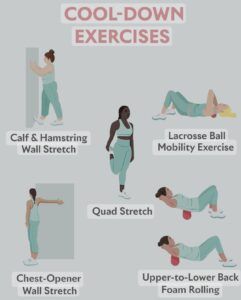
Cooling down after exercise is essential for many reasons. Here are some of the reasons why cooling down is so important:
- Helps gradually lower heart rate and blood pressure back to resting levels, reducing the risk of dizziness or fainting.
- Allows for the gradual removal of metabolic waste products, such as lactic acid, from the muscles, reducing soreness and stiffness.
- Prevents blood from pooling in the extremities by promoting venous return to the heart, which can help prevent post-exercise light headedness.
- Promotes relaxation and reduces stress by transitioning the body from a state of heightened activity to a state of rest.
- Facilitates the recovery process by promoting muscle repair and rebuilding, ultimately aiding in improved performance and readiness for future workouts.
Cooling down is essential for safely transitioning the body from exercise back to a resting state, promoting recovery, and reducing the risk of post-exercise discomfort or injury.
Top 10 Warm-Up Dynamic Exercises
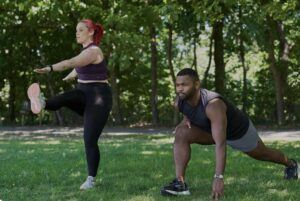
Before beginning any physical activity you should spend 5-10 minutes doing light cardio and dynamic stretches.
Dynamic stretches are essential to warm up your body and increase blood flow to your muscles, preparing them for physical activity.
Below are 10 dynamic stretches I perform regularly in my warm up routines.
- Leg Swings: Stand next to a wall or support, and swing one leg forward and backward, then side to side, to increase hip mobility.
- Arm Circles: Rotate your arms in small and large circles to loosen shoulder joints and muscles.
- Hip Circles: Rotate your hips in circles to improve hip mobility and flexibility.
- High Knees: Lift your knees as high as possible to warm up your lower body and core.
- Butt Kicks: Kick your heels toward your glutes to stretch your quads and hamstrings.
- Walking Lunges: Take large steps forward and perform lunges to activate leg muscles and improve flexibility.
- Hip Flexor Stretch: Take a step forward and lower your hips to stretch the hip flexors while keeping your back leg straight.
- Ankle Circles: Rotate your ankles in circles to improve ankle mobility and reduce the risk of ankle injuries.
- Torso Twists: Stand with your feet hip-width apart and twist your torso from side to side to warm up your core and spine.
- Arm Swings: Swing your arms forward and backward to engage your shoulders and upper body.
It is important to perform these stretches in a controlled manor and gradually increase the range of motion as your body warms up.
You should adapt your warm-up to the specific activity you are about to perform. For example if you was training upper body you should focus mainly on upper body stretches and if you was training lower body you should focus mainly on lower body stretches.
Top 10 Static Cool Down Stretches
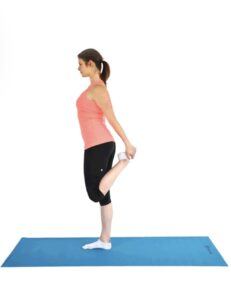
Cooling down after physical activity is important to reduce the risk of injury and promote recovery.
Here are 10 stretches I perform regularly in my cool down routines.
- Standing Quadriceps Stretch: Stand on one leg and pull your other heel towards your glutes to stretch your quadriceps.
- Hamstring Stretch: Sit with one leg extended and the other leg bent so the sole of your foot touches your inner thigh. Reach forward to stretch your hamstrings.
- Calf Stretch: Stand facing a wall with one foot forward and one foot back. Lean into the wall to stretch your calf muscles.
- Hip Flexor Stretch: Kneel with one foot forward and the other knee on the ground. Gently push your hips forward to stretch the hip flexors.
- Butterfly Stretch: Sit with your feet together, and gently press your knees toward the ground to stretch your inner thighs.
- Child’s Pose: Kneel on the ground and sit back on your heels while reaching your arms forward to stretch your back and shoulders.
- Cat-Cow Stretch: Start on your hands and knees. Arch your back upward (cat) and then downward (cow) to stretch your spine.
- Triceps Stretch: Raise one arm overhead and bend your elbow, then use your opposite hand to gently push your elbow to stretch the triceps.
- Shoulder Stretch: Cross one arm in front of your chest and use the opposite hand to gently pull it closer to your body.
- Neck Stretch: Gently tilt your head from side to side and forward and backward to stretch your neck muscles.
Hold each stretch for 15-30 seconds whilst remaining relaxed and focusing on deep breathing. Cooling down with these stretches can help reduce muscle soreness and improve flexibility.
Conclusion: Key Points to Take Away
In conclusion, the importance of warming up and cooling down cannot be overstated when it comes to physical activity. Warming up prepares your body and mind for exercise by increasing blood flow, flexibility, and coordination, while reducing the risk of injury.
Cooling down, on the other hand, allows your body to safely transition from exercise back to a resting state, promoting recovery and reducing post-exercise discomfort. By incorporating dynamic warm-up exercises and static cool-down stretches into your routine, you can enhance performance, prevent injuries, and support overall well-being.
Remember, taking the time to properly warm up and cool down is an investment in your health and fitness journey. So, whether you’re hitting the gym, going for a run, or engaging in any physical activity, make sure to prioritize these essential components for a safe and effective workout experience.
I hope this article helps gives you a better understanding of the importance of warming up and cooling down. If you have any questions about lower back pain or about fitness in general, leave a comment below and I will get back to you as soon as possible.
Let’s stay strong, stay healthy, and keep moving forward on our fitness journey’s.
